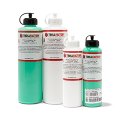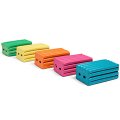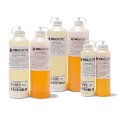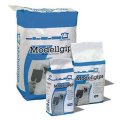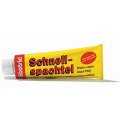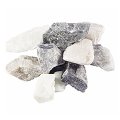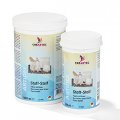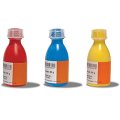Impression silicone
Information about impression silicone
Silicone
To formulate the following text using only those technical terms whose meanings had already been explained was only possible within limits. With this in mind, we have added a “Small Lexicon for Silicone” as a PDF-file. If you are having trouble understanding some of the explanatory texts, please have a look there.
The raw material used to produce silicone is silicon which is, after oxygen, the second most prevalent element in the earth’s crust. The brittle, hard, grey-black metalloid is found in nature as silicon dioxide (rock crystal, quartz, sand) or in the form of silicates (silicon compounds with aluminium, calcium or magnesium). Silicon is an extremely versatile material: it constitutes the basic component of glass (melted quartz) and porcelain (pulverized quartz), is used in the semi-conductor technology for computer chips (“silicon valley”) and in the production of solar panels. The silicone that is made from silicon consists chemically of long chains which combine alternating atoms of silicon and oxygen. Residues of hydrocarbons hang on the silicon atoms with the result that silicone can repel water but steam can penetrate through it. Silicones can be distributed in (liquid) oils, (rubbery) caoutchouc and (congealed) resins.
2-component silicones cure into elastomers which are distinguished by their high elasticity, physiological harmlessness, self-releasing attributes (they will not stick on other smooth surfaces) and relatively high temperature resistance (long-term up to 180 °C and short-term up to 220 °C). All of the silicones on offer at Modulor are easy to use moulding silicones which produce very precise reproductions. RTV-2 silicones are comprised of 2 components which must be thoroughly mixed with one another and which are able to vulcanize (crosslink) at room temperature without producing any reaction heat.
The mixing ratio of component A (polymer) and component B (crosslinking agent) is always based on weight (not volume!) and should be attended to exactly. Using more or less hardener than what is given in the formulation will not as a rule lead to a faster or slower curing but instead will only tend to disrupt vulcanization or cause inadequate crosslinking, both of which will have detrimental effects on the mechanical integrity of the final silicone rubber. If only a partial amount is used from a package, it is essential that it be weighed exactly so as to be able to comply with the respective mixing ratios.
The designations “Sh-A” or “Sh-D” stand for “Shore hardness”, which is a relative measure of the hardness of elastomers and plastics. In the case of soft, rubber-like materials, the Shore hardness A is used; for harder materials the Shore hardness D. The process for determining Shore hardness, which is standardized under DIN 53505 and DIN 7868 (German Industrial Norms), consists in taking a hardened steel pin, which has a different shape for the A and D tests respectively, and pressing it into the material with a specific amount of force and measuring the depth of penetration. The given measurement value is based on a scale of 0 (total penetration) to 100 (no penetration) – the higher the number, the harder the material.
Silicone is divided into two groups based on the type of crosslinking involved: addition-crosslinked and condensation-crosslinked. The type of crosslinking determines different attributes in both types of materials; the following table provides information about these differences.
Comparison of addition and condensation silicones
| Attributes – components/treatment | Addition-crosslinked silicone1) | Condensation-crosslinked silicone1) |
| Fillers | fillers or no fillers | always has fillers |
| Working Life (at room temp) | relatively short | relatively long |
| Linear shrinkage | max. 0.1 % | approx. 1 % |
| Vulcanization in a closed system? | yes ( because not a cleavage product) | no (condensation must evaporate and atmospheric moisture be absorbed) |
| Risk of inhibition | relatively high | low |
| Inhibition occurs because of (examples): |
|
|
| De-moulding time (at RT) | relatively short | relatively long |
| Annealing | possible: up to 150 °C (mould at room temperature is marginally more shrunken than one that was made at normal temp.) | not possible (treatment from 20 °C to 50 °C) |
| Toxicological/hazard info | neutral, toxicologically safe (not a cleavage products) | can be hazardous to health (cleavage products) |
| Attributes of the material when cured | ||
| Transparency | translucence or transparency possible | translucence or transparency possible |
| Time before first use of the mould2) | approx. 24 hours after de-moulding | approx. 1 week after de-moulding |
| Service life of the mould | relatively long | relatively short |
| Price | approx. 20% more expensive than comparable condensation-crosslinked silicone | approx. 20% less expensive than comparable addition-crosslinked silicone |
| Comments | ||
| Special features |
|
All the information refers primarily to the materials on offer at Modulor.
1) under no circumstances can addition and condensation crosslinked silicones be mixed together!
2) at room temperature (annealing possible if applicable)
Addition-crosslinked silicones vulcanize without the addition of cleavage products and will not shrink as a result. They are the right choice if the moulding process must produce precise results and the subsequent mould needs to be put to use as soon as possible after curing. The final mechanical attributes of addition-crosslinked silicone are achieved after about 24 hours. The speed and the evenness of the process of their crosslinking reaction are not influenced by either the thickness of the mould or by the circumstances of a closed system (no air or moisture supply). The risks of inhibition require that this silicone be worked with conscientiously and in absolutely clean conditions.
Addition-crosslinked silicone should also be the preferred choice in the following circumstances as well: if a short working life and de-moulding time and an accelerated processing (see “Annealing”) are important to you or if the service life of the mould (e.g. in serial production) is a serious consideration. Because this silicone is available without fillers and therefore can be transparent or translucent, it is especially good for making single piece block moulds where the process of removing the mould from the master pattern involves cutting it: you will be able to see all the way through to the master pattern and to avoid damaging it during the cutting process.
One component of the addition-crosslinked silicone always contains a platinum catalyst. Even very tiny amounts of this catalyst is enough to cause the curing to begin if it comes into contact with the other component. Such a “contamination” can occur if an open package of component A is allowed to stand next to an open package of component B. It is therefore mandatory that any container be immediately closed back up after some of its contents have been taken out. Any tools that have come into contact with the component that has the catalyst or with the mixture of both components must be thoroughly cleaned after use in order to avoid any future contamination.
Even though most of the silicones that we have on offer are not designed for making body casts, addition-crosslinked silicone is often used for this purpose because of its neutrality (not a cleavage product). When being so used over large areas we definitely recommend that a preliminary test be made (e.g. on the little finger). Silicone that has been tested on the human body and therefore proven to be safe for such work is available for purchase upon inquiry.
Condensation-crosslinked silicones vulcanize with the addition of cleavage products (alcohols) – they decrease in the process of the crosslinking reaction by about 1%. In order to achieve the complete evaporization of the cleavage products and reach the ultimate mechanical attributes, the moulds, after curing, should not be used right away but rather set aside for about 1 week. This time span can be shortened by taking the silicone rubber that had vulcanized at room temperature and storing it many hours at temperatures between 50 °C and 70 °C (but definitely not any hotter!). Because the condensation has to evaporate during the curing process and the crosslinking of this silicone requires a certain amount of atmospheric moisture, it should not be utilized within the confines of a closed system. Because of its low risk of inhibition, condensation-crosslinked silicone should always be the type used when your moulding work is to be done in unclean surroundings (e.g. outdoors).
Its longer working life and de-moulding times should be taken into account when working with this type of silicone. Condensation-crosslinked silicone is thus always the proper choice if you are to be working without a vacuum forming machine because any bubbles caused by stirring will be better able to escape during the longer period of the working life. Processing this silicone should be done at temperatures between 20 °C and (maximum) 50 °C. Higher temperatures will cause the reversal of the crosslinking reaction – the system will remain, or become again, liquid. Because condensation-crosslinked silicones contains fillers, component A must always be thoroughly stirred before it is then mixed with component B.
Storage and Shelf Life: The individual silicone components are perishable. Their shelf lives with proper storage are given at each individual product. The prerequisites for the given shelf life times and successful results from the processing are frost-free storage in unopened original packages at temperatures under 30 °C. Any partial amounts taken out of a package should never be put back.
The finished silicone moulds also have a limited shelf life – they can only be used a limited number of times before they become brittle and unsuitable for use. The shelf life of a silicone mould depends on various aspects (see “Shelf life”).
Safety at work: Working with silicone therefore only requires that the generally accepted rules of safety be heeded. Only the hardeners from condensation-crosslinked silicones are caustic. They, then, should be kept away from your skin or your mouth and if they come in contact with your eye cold water should be used to thoroughly wash it out. If the irritation persists a doctor should be consulted. We will be glad to send you safety data sheets upon request. When still in the fluid, not completely cured state, the components can be hazardous to water and should therefore not be allowed to enter into drains or soils.
Treatment: In order to achieve the most exact possible reproduction of the master pattern, it will be well worth your while to take extreme care during the most important part of the work – namely, the making of the mould. The silicone mould can only reproduce what it has been able to “pick up” from the structure of the surface of the original. Whether a cast piece, for example, has a matte or glossy surface after being de-moulded depends on the degree of gloss of the silicone itself as well as that of the master pattern. Technically speaking, a more matte surface is really only one that is somewhat rougher (larger pored) than a glossy one. Because a moulding silicone exactly captures the surface texture of a material, it will reproduce the material’s degree of gloss on the resulting cast piece.
For working with smaller amounts of silicone rubber we recommend that you have the following tools and aids ready at hand on a clean working area that is large enough to handle your project:
•a substrate (like a newspaper)
• disposable gloves, latex
• rags for wiping up errant dropping
• clean, dry measuring cup, Disposable Syringes, and/or an exact
scale for making precise measurements of the individual components
• wooden stirring spatula, or better, a mixing cup
• a stiff, short-haired bristle brush
• grease dissolving cleaning agent (e.g. acetone or cleansing petrol)
The master pattern that is the basis for a silicone mould must be dry, clean, dust-free and portative. Moulding silicones have self-releasing attributes – when making a mould they do not stick to the master pattern and the resulting cast pieces will also not stick to the cured silicone mould. We do, however, still recommend that a release agent be employed.
Porous materials like, for example, wood, natural stone or plaster should always be sealed and covered with a release agent in order to stop the moulding material from penetrating the surface and making the eventual de-moulding more difficult. For sealing work, most materials will only require a concentrated soap solution (detergent) or methyl cellulose (thin wallpaper paste) both of which can be washed off later. As an alternative, the materials can be painted in order to close up the pores.
Basically, the character and the size of the master pattern will determine the type of mould and the moulding technique. Different types of moulds include block moulds, skin or flexible moulds or shell moulds. In terms of the consistency of the finished silicone mixture, there are pourable, spreadable and kneadable silicones – these are used in pouring, spreading and impression techniques. An overview of the advantages and disadvantages of the various mould types and processes can be seen in the following chart.
Moulding techniques
| Master pattern (description) | Type of Mould | Moulding Technique | Advantages | Disadvantages |
|
single piece block mould | pouring or impression techniques |
|
uses a relatively large amount of silicone |
|
flexible (skin) mould | pouring or spreading techniques |
|
mother mould required (more work effort) |
|
block mould, single piece (de-moulding by means of cutting along a dividing line) → use as two or more piece block mould | pouring technique |
|
relatively large amount of silicone needed |
|
flexible mould, single piece (de-moulding by means of a side-cut) → use as single piece flexible mould which can be folded away at the cut | pouring or spreading techniques |
|
mother mould required (more work effort) |
|
block mould, two or more piece | pouring or impression techniques |
|
relatively more effort and silicone required |
|
flexible mould, two or more piece | pouring or spreading techniques |
|
mother mould required (more work effort) |
Before mixing the two components together each must be stirred well – especially in the case of silicones which contain fillers. In order to create a silicone rubber that is ready for use and to achieve its trouble-free vulcanization, both components must be placed in a clean mixing bowl in the correct mixing ratios (parts per weight!) and carefully mixed together with special attention given to the walls of the bowl (by hand with a spatula or with an electrically driven stirrer). For purposes of monitoring, the two components are usually different colours. If you do not have an exact scale available, you will have to turn to using volume measurements taking into account the different densities of the components (see, the chart “Elastic Moulding Materials – Our Products in Comparison”)
When doing your mixing – especially if working without a vacuum device – care must be taken that as few bubbles as possible are produced during the stirring because they will negatively affect the exactness of the mould and the future mechanical attributes of the cured casting material. If you are using a mixing device like a drill it should be set at a low speed for the same reason – this will also prevent the mixture from becoming hot. If you intend to use a great deal of addition-crosslinked silicone, we recommend that a metre-mix machine for 2 component systems be used.
If a vacuum device is available, the freshly stirred silicone mixture should be put in a mixing bowl, this then placed in the vacuum chamber and de-aerated. In doing so, it should be noted that a much larger container for the silicone mix is required because the silicone will expand considerably in the chamber (see, “Vacuum device”). When working without a vacuum device, please keep in mind that some of the working life of your mixture will be used up during the de-aeration process. The less the viscosity of the stirred silicone mixture, the better the de-aeration will be.
After de-aeration, the silicone rubber should be slowly poured into the casting frame (container (box) with the master pattern within it). During this step as well, care must be taken that no bubbles are allowed to develop – especially on the surface of the master pattern. In order to prevent this, a long thin stream should be poured from a height between 20 and 30 cm beginning at the lowest point and progressing upwards.
Thixotropic (pasty) silicones should be applied with a brush in the first step in order to produce the thickest and most bubble-free possible coverage. As soon as the first coat has set up but is still sticky, a second coat should be applied with a spatula in a thickness as close to the first coat as possible. If you still haven’t produced the thickness you require, more coats can be applied with a spatula as long as the previous coat is still sticky (see, “Glove technique/Flexible mould”) When making moulds with kneadable silicone, it should be applied immediately after mixing in a single step in the thickness that is required.
The vulcanization process begins at the end of the working life – the components interlink into an elastic silicone rubber. If the vulcanization process needs to be appreciably accelerated, an addition-crosslinked silicone must be chosen because that system can be annealed at higher temperatures.
As soon as the silicone is cured and no longer sticky it can be de-moulded. Single piece block moulds are de-moulded by carefully cutting them along a pre-determined line with a scalpel. Such moulds should therefore be made with transparent or translucent silicone because being able to see through to the master pattern itself during the cutting process makes it that much easier to avoid damaging it. The silicone mould should then be carefully pulled away from the master pattern. In doing so, it must be slowly pulled free from the undercuts by taking advantage of the stretchability of the silicone (see, “Glove technique/Flexible mould).
Depending on whether an addition-crosslinked or a condensation-crosslinked silicone is to be used for making the mould, the mould must subsequently be stored for one day or one week, respectively, before being used for the first time (see, Comparison of the Two Interlinking Types by clicking on Modelling, Moulding, Casting then on “Addition-crosslinked silicone” and at that page on “General information about Addition-Crosslinked Silicone” at the top). Suitable casting materials include plaster and plaster containing materials, plaster/acrylic casting resins, cement, wax, unsaturated polyester casting resin, PUR casting resins or foams, epoxy casting resins, etc. If aggressive casting media are used, you should allow the silicone mould to aerate overnight so that it will not become brittle too quickly. In order to lengthen the service life of a silicone mould, it is recommended that you rub in some silicone oil from time to time or spray it with silicone spray.
A comprehensive selection of casting resins can be found in the section so named under the heading “Modelling, Moulding, Casting”. For making your selection and for information concerning working with the various casting materials, please consult the appropriate texts in that section. polyurethane or latex can be used particularly as an alternative to silicone.
